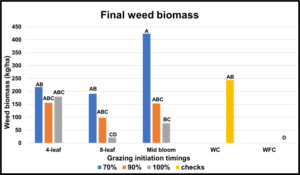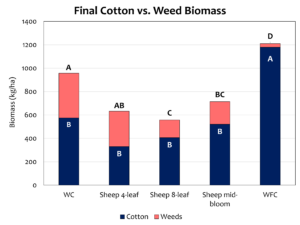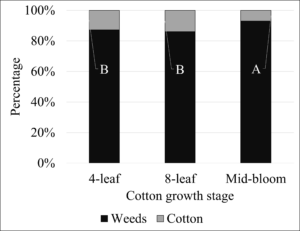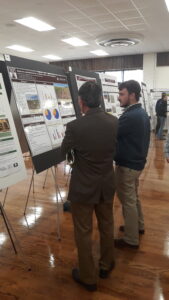Progress report for LS22-375
Project Information
The economic opportunity represented by organic cotton premiums has captured the interest and commitment of many producers across the South. Semi-arid West Texas is conducive to successful organic cotton production due to generally lower pest and disease pressure (and reduced reliance on pesticides) compared to much of the Cotton Belt. However, mechanical- and hand-weed control are not environmentally nor economically sustainable. Due to limited water, portions of irrigated land are left fallow and rotated annually. During fallow periods, this acreage is plowed several times to suppress weeds. Sheep integration in organic cotton systems has potential to suppress weeds, reduce tillage, and add value to the overall system. Furthermore, conversion of dry acreages to perennial forage crops would be more environmentally sustainable than the current regime, and would supplement sheep grazing opportunities. A new system, integrating sheep, cotton, annual forages, and perennial forages poses unique potential for diversification and ecological resilience. The proposed research seeks to identify optimum practices for “sheep-weeding” in organic cotton (i.e. cotton growth stage, sheep stocking rate and duration). The work will also assess establishment methods and species for conversion of degraded cropland to perennial forages. System impact will not be based on single response variables, but a network of components characteristic of the whole system. This comprehensive set of field research trials will be coupled with dynamic economic analyses to explore critical questions and inform educational products for the public. An advisory council of stakeholders will guide efforts and help interpret and leverage findings and future work.
Objective 1. Employ Neef and Neubert’s six dimensions of participatory research framework to facilitate positive, favorable interaction between researchers and stakeholders and enhance the viability and livelihood of organic cotton stakeholders in the South.
a. Coordinate needs assessment via Q-methodology to explore stakeholder perspectives, needs, and expected benefits and outcomes of the proposed project.
b. Establish a project advisory board
c. Host regular town-hall meetings to convene with stakeholder groups on research progress and direction.
Objective 2. Assess agronomic and stocking management implications of sheep-weeding in cotton
a. Year 1: Evaluate timing of sheep-weeding initiation relative to cotton growth stage, and sheep-weeding termination relative to varying thresholds of weed herbage mass removal.
b. Years 2 and 3: Compare optimized sheep weeding strategy (from Obj. 2a) to alternative and otherwise standard weed management systems.
Objective 3. Identify best-suited perennial and annual forage management options for converted land
a. Test establishment success, forage yield and nutritive value, and soil health indicators across a range of forb inclusion rates with native perennial grasses.
b. Assess forage yield, nutritive value, and sheep grazing preference among summer and winter annual legumes and legume-grass mixtures.
Objective 4. Develop, deliver, and test public resources, economic decision support tools, and stakeholder resources for continued education and assessment of sheep-weeding practices.
a. Economic enterprise budgets informed by measurements in Objectives 2 and 3.
b. Develop and deploy reusable learning modules
c. Publish findings in popular press articles and develop educational videos
Cooperators
- - Producer
- - Producer
Research
Years 1 and 2 Field Research Trials
Sheep-weeding in Cotton - This experiment was conducted in San Angelo, Texas during the 2022 and 2023 cotton growing seasons at the Angelo State University Management, Instruction, and Research (MIR) center. A travelling irrigator was used persistently in response to the abnormally hot and dry growing seasons in both years, but both crop and weed growth were limited by the environmental conditions. Portable electrified net wire fencing was used to separate plots and contain sheep during grazing events. Electric net fencing also served as a barrier to help keep deer pressure down in the plots. The trial was designed as a 3x3 factorial with treatments including three different cotton growth stages to initiate grazing (4-leaf, 8-leaf, and mid-bloom) and three different levels of grazing intensity (approximately 70%, 90%, and 100% weed removal with presumably greater cotton damage with increasing intensity). Differences were identified using α = 0.1. Each replication also included a weedy-check and weed-free check. To maintain our weed free check (WFC), chemical control was used at the beginning of the season and then manually weeded throughout the season. Our weedy check (WC) had no control. The trial was arranged in a randomized complete block design with four replications. Before and after each grazing initiation, aerial imagery was collected with a UAV. This allowed quantifying weed biomass removal by sheep by analyzing weed canopy cover percentage before grazing and removal after grazing. In 2022, quadrat imagery and clippings were collected (three 0.67 m2 quadrats per plot) as another way to quantify weed biomass removal. Based on evaluation of 2022 physical clipping vs. aerial imagery data, the aerial imagery was determined to better represent treatment effects to whole plot areas, and was continued in 2023. During each grazing treatment, notes were taken every five minutes on the number of sheep grazing weeds, grazing cotton, and how many were idle in the plot. These numbers were converted to sheep grazing hours per hectare (SGH ha-1) to determine, in scalable units, a level of grazing intensity required to accomplish the same amount weed removal. In the first and second initiation timings, sheep were grazed in the plots two or one more time during the season for plot maintenance. To measure final cotton and weed biomass, all cotton plants were harvested from a 3-m length of two center rows per plot, and weed biomass was harvested from the same area, including the interrow space. Biomass was weighed fresh then subsampled (approx. 500 g) for dry matter determination.
Perennial forage trials were planted at San Angelo and Lubbock, TX in spring 2023 and spring 2024. Plots are 5 × 20 ft and treatments (forb inclusion rates = 0, 20, 40, and 60% pure live seed) were planted in a randomized complete block design with 4 replications. Overall, establishment failed at both sites in 2023. To-date in 2024, some of the native grasses have established at the San Angelo site; however, this objective has proven extremely difficult to address particularly under extreme heat and drought conditions.
Summer annual forage trials were planted at one site in 2022 and three sites in 2023. The site in 2022 failed, as well as one of the sites in 2023. Data collected from successful sites has been compiled, analyzed, and shared with stakeholders via Extension outlets. Winter annual forage trials were planted at two sites across West Central Texas, comparing forage yield of winter legumes in combination with triticale and turnips. Trials were successfully established and sampled in 2022.
Both growing seasons so far were extremely hot and dry in West Texas. In 2022, San Angelo experienced the hottest July on record (in 116 years), with an average daily high of 103.5 F and average temperature of 89.7 F. The area received only 3.37 inches of rain from January through July (71% below average for this period). Due to these conditions, all summer annual forage trials failed (as all sites were non-irrigated). In 2023, record high temperatures were observed in June (daily record of 115 F) and the area experienced the hottest August on record. The sheep-in-cotton trial was irrigated as frequently as possible throughout the season, enabling enough plant growth for crop and weed measurements, but water was inadequate for harvestable cotton production in both years.
In the first year of the sheep-weeding trial, grazing intensity had the greatest effect on total weed biomass (p = 0.036), weed canopy (p = 0.024), and the cotton to weed ratio (p = 0.074). The most intense grazing treatment (target 100% removal) at the 8-leaf initiation resulted in 89% and 49% greater weed biomass reduction than the least and moderately intense treatments, respectively. Similarly, the most intense grazing treatment at the mid-bloom initiation reduced weed canopy cover 33% and 80% more than the least and moderate intense grazing, respectively. Final weed biomass was less due to 8-leaf initiation with 100% weed removal (21 kg ha-1) than mid-bloom initiation with 100% weed removal (77 kg ha-1), 4-leaf initiation with 100% removal (180 kg ha-1), as well as the weedy check (244kg ha-1) (Figure 1). Grazing initiation time had the greatest effect on total amount of sheep grazing minutes required for each plot (p < 0.0001). To achieve the same weed biomass removal as the 4-leaf grazing initiation, 8-leaf and mid-bloom initiations required 46% and 135% more sheep grazing minutes, respectively. As sheep were introduced into each plot, they all were not eating at the same time and/or throughout the entire time in the plot. The SGM unit allows for a more quantifiable metric to determine how long sheep should be grazing in the plot, rather than time (e.g., 30 minutes, 1 hour). Weed management treatments did not influence cotton canopy or final cotton biomass, likely due to a season of severe drought. Timing (cotton growth stage) of grazing initiation also did not influence cotton canopy, cotton biomass, weed biomass, and weed canopy to the same effect as grazing duration.


Over both seasons (2022 and 2023) combined, grazing intensity effects were not significant within initiation timings, although a consistent relationship was observed with greater reductions of weed biomass at the later grazing timings, and in the weed free check, compared to the earlier grazing timings and the weedy check (Figure 3).

As grazing intensity was ultimately insignificant in our measured responses across years, a simplified analysis was conducted comparing only sheep grazing initiation timing to the weedy and weed-free checks. This showed that ultimate weed biomass was reduced in the sheep weeding treatments initiated at the 8-leaf growth stage and mid-bloom, although this reduction of weed biomass did not result in increased cotton biomass (Figure 4). Sheep spent considerably more time grazing weeds than cotton (Figure 5), but as greater herbivory on the cotton occurred at earlier growth stages, we conclude that even slight early-season grazing damage to the cotton resulted in ultimately reduced/compromised yield potential. As the cotton matured, sheep grazed cotton only ~10% of the time compared to ~15% at earlier stages; however, by this point in the season the damage to cotton yield potential via weed competition had likely already occurred.


Education
Educational goals/deliverables include the development and dissemination of two reusable learning modules, six Extension and popular press articles, and two educational videos. Further, graduate student education is underway with two graduate research assistants on the project.
Years 1 and 2 Progress:
M.S. student Matthew Stewart began his assistantship on this project in May 2022, coordinated both years of field research trials integrating sheep into cotton systems, and graduated in May 2024. Matthew shared his research findings at six different academic conferences (photos below): in an oral presentation at the American Society of Agronomy Meetings (Baltimore, MD) in 2022, and as a research poster at the Texas Plant Protection Conference (Bryan, TX 2022 and 2023), the Beltwide Cotton Conferences (New Orleans, LA in 2023 and Fort Worth, TX in 2024). He placed 2nd in the graduate student poster competition at Texas Plant Protection in 2022 and won 1st place in 2023, and placed 3rd in the Sustainability Conference at Beltwide in 2023. Matthew completed and defended his thesis and has started a job with a research farm in Georgia. We working to submit his thesis research as a peer-reviewed scientific publication in the near future.

Two different M.S. students began working with Dr. Holli Leggette on the participatory research, communication, and outreach components of the project, but both left for reasons unrelated to this project. Another student has helped continue that part of the project, and Dr. Leggette has a plan to involve other students in the process as the work continues.
Educational & Outreach Activities
Participation Summary:
One direct consultation was made in the first year with a producer who had integrated similar practices previously and was considering options to continue using sheep on his organic cotton farm, and two consultations were made with producers in the second year. The project team also coordinated with 2 key producers to host RFD-TV America's Heartland film crew who featured SARE with a special feature (reported as an on-farm demonstration). This feature can be viewed here (beginning at 12 minutes 30 seconds): https://www.youtube.com/watch?v=C6c80w72S0s . The communications team from Angelo State University (collaborating institution) also featured our work in their January 2023 magazine "Fiat Lux" and on their Agriculture Department's website: https://www.angelo.edu/live/news/19128-research-at-the-ranch.
In 2023, this work was presented to two different groups of NRCS professionals at workshops geared toward livestock integration and stewardship (~30 per course). One of these events occurred in conjunction with sheep grazing events, so the participants were able to tour the field trial and observe the sheep grazing in the plots. The project was also shared at the 2023 Texas Youth Sheep and Goat Tour (32 participants on June 2023) and the Texas Sheep and Goat Field Day (~92 participants on August 2023).

Project Outcomes
To-date, this project has primarily focused on coordinating field research trials and building relationships with collaborators and stakeholder groups. Actual quantification of project outcomes in terms of knowledge gained and practices adopted will be most evident in the final year of the project. This work has been leveraged for another grant proposal (with NRCS) which is currently pending.
